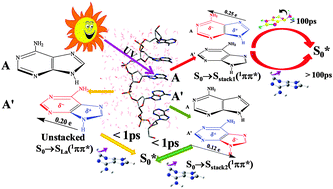Slow deactivation channels in UV-photoexcited adenine DNA†
Abstract
The molecular mechanism for removing the excess energy in DNA bases is responsible for the high photostability of DNA and is thus the subject of intense theoretical/computational investigation. To understand why the excited state decay of the stacked bases is significantly longer than that of the monomers, we carried out electronic structure calculations on an adenine monomer and an aqueous (dA)5 oligonucleotide employing the CASPT2//CASSCF and CASPT2//CASSCF/AMBER levels of theory. The newly-found bright excited state pair Sstack1(1ππ*) and Sstack2(1ππ*) of d(A)5, originated from base stacking, is of intra-base charge transfer nature and occurs in different stacked bases with charge transfer along opposite directions. Two slow deactivation channels of d(A)5 were proposed as a result of the sizable barriers along the relaxation paths starting from the FC point of the Sstack1(1ππ*) state. The SN1P(1nπ*) state of d(A)5 serves as an intermediate state in one relaxation channel, to which a nonadiabatic decay from the Sstack1(1ππ*) state occurs in an energy degeneracy region. A relatively high barrier in this state is found and attributed to the steric hindrance of the DNA environment due to the large NH2 group twisting, which gives a weak and red-shifted fluorescence. Another direct relaxation channel, induced by the C2–H2 bond twisting motion, is found to go through a conical intersection between the Sstack1(1ππ*) and the ground state. The barrier found here enables fluorescence from the Sstack1(1ππ*) state and may explain the bright state emission observed in the fluorescence upconversion measurements. The inter-molecular SCT(1ππ*) state may be involved in the slow relaxation process of the photoexcited adenine oligomers through efficient internal conversion to the intra-base Sstack1(1ππ*) state.


 Please wait while we load your content...
Please wait while we load your content...